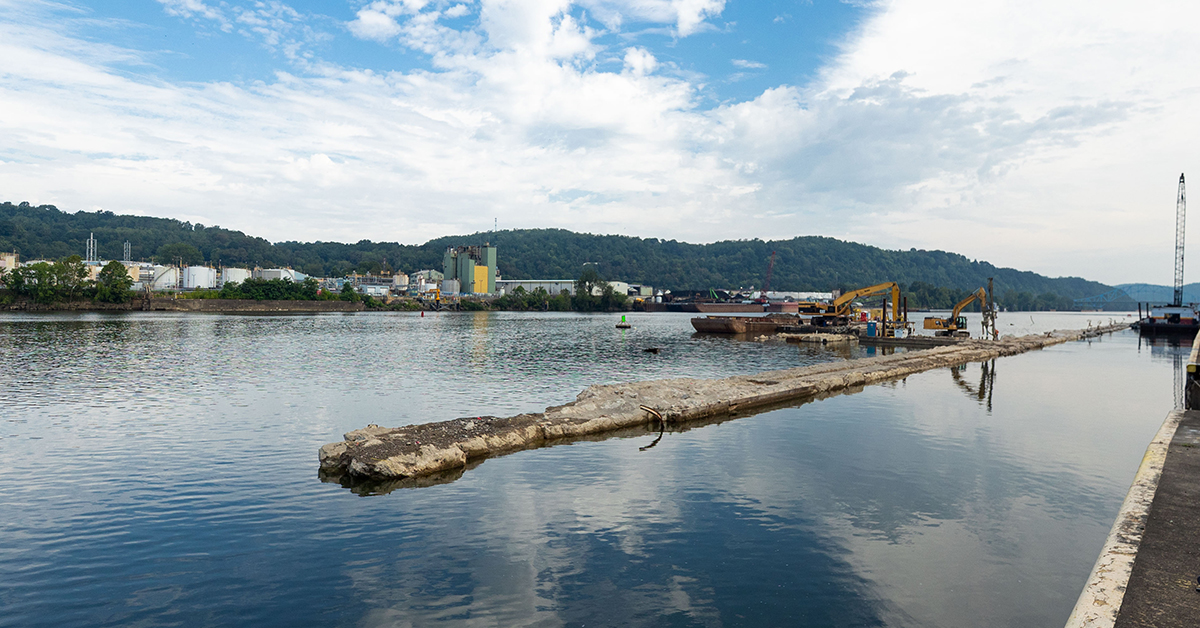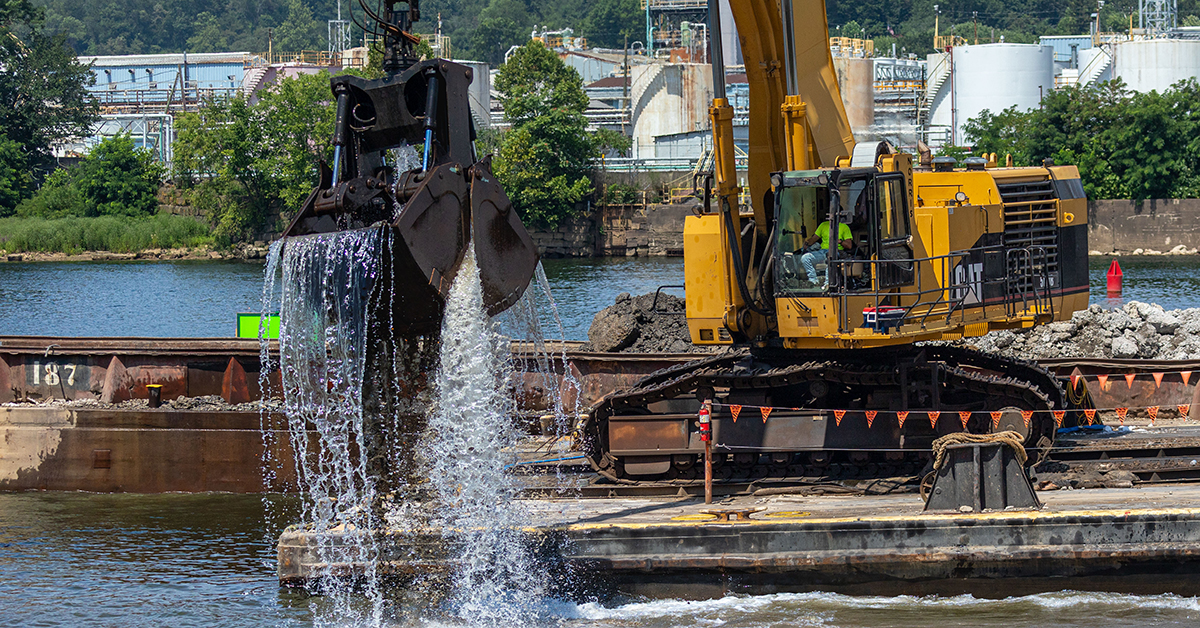Explosive blasting to remove the old lock walls at Monongahela River Locks and Dam No. 3 near Elizabeth, Pa., is estimated to be 50 percent complete.
Crews began removing lock walls July 1, said Andrew Bechtold, the resident engineer for the project. The controlled blasts are expected to continue two to three times weekly through September. All blasts take place between 7 a.m. and 5 p.m. Monday through Saturday.
Removing remaining portions of the walls was the next step in demolition of the old locks and dam. The landside lock wall adjacent to the shoreline and the dam abutment will remain in place, with the concrete debris from the locks and dam removal repurposed to help stabilize them against the riverbank.
Project History
Commonly called the Elizabeth Locks and Dam, Locks and Dam 3 had operated at Monongahela River Mile 23.8 since 1907 but was prone to flooding and had to be shut down during high-water events, according to the Corps.
Contractors breached the fixed-crest dam at Elizabeth on July 10, 2024, opened a 100-foot-wide navigation channel September 5 to accommodate 9-foot-draft tows, expanded that opening to 300 feet on December 20 and completed the dam’s removal in January.
The locks and dam’s removal caused the water level to rise downriver between Elizabeth and Braddock Locks and Dam and caused it to drop upriver between Elizabth and John P. Murtha Locks and Dam at Charleroi, Pa. A data miscalculation meant the upstream drop was lower than expected at some locations in the pool, resulting in the need for additional dredging.
The navigable pass now in place at Elizabeth creates a 30.2-mile-long pool between the remaining dams, designed to reduce delays and increase economic efficiencies.
The locks and dam demolition at Elizabeth is part of the Corps of Engineers’ Lower Monongahela River Project. The project included replacing the fixed-crest dam at Locks and Dam 2 at Braddock, Pa., with a gated dam, constructing a new, larger lock at Locks and Dam 4 at Charleroi, Pa., which was renamed the John P. Murtha Locks and Dam, and removing Locks and Dam 3.

These were the three oldest operating navigation facilities in the country, according to the Corps of Engineers, and they experienced the highest volume of commercial traffic on the Monongahela River Navigation System.
Moving Forward
Crews began removing the middle and river walls of the Elizabeth locks to about 2 feet above the water level January 13, using excavators and jackhammers.
“The U.S. Army Corps of Engineers Pittsburgh District and its contractors completed demolishing the fixed-crest dam and the mechanical demolition of the lock walls above the Monongahela River waterline,” Bechtold said. “The contractor is currently conducting controlled demolitions to remove the remaining lock walls below the waterline, remove the land wall buildings and install stability berms along the land wall.”
As a whole, about 75 percent of the lock and dam complex has been demolished, Bechtold said.
“During controlled blasting, river traffic is temporarily paused from passing through the work zone to ensure the safety of all vessels and crew,” he said. “Once the area is cleared and deemed safe, river traffic can resume. Outside of controlled blasting, river navigation is open with appropriate guidance to avoid construction areas.”
One contract remains on the Lower Mon Project. A contract expected to be let at John P. Murtha Locks and Dam at Charleroi in 2026 will stabilize the downstream guidewall and place struts across the landside lock chamber, making it possible to continue using the chamber to lock debris out of the upstream lock approach following high-water events. The chamber can also be used to flush ice from the approach during winter weather.
As expected, the landside chamber at the lock is no longer useable for navigation traffic because of the lower water level caused by the breaching of Lock and Dam 3 at Elizabeth. Work to recapitalize the landside chamber at John P. Murtha has been deferred until the 2050s.
The Joseph B. Fay Company of Pittsburgh is the primary contractor for the Lower Monongahela Project. The contract completion date has been set for April 2027.
Featured image caption: Heavy equipment picks rubble off the bottom of the Monongahela River following a controlled explosive blast being used to remove some of the lock walls at the former Monongahela Locks and Dam No. 3 at Elizabeth, Pa. (Photo by Andrew J. Byrne/Pittsburgh Engineer District)




